Instructor’s Manual to Accompany
Introduction to
Probability Models
Ninth Edition
Sheldon M. Ross
University of California
Berkeley, California
AMSTERDAM • BOSTON • HEIDELBERG • LONDON
SAN FRANCISCO • SINGAPORE • SYDNEY • TOKYO
NEW YORK • OXFORD • PARIS • SAN DIEGO
Academic Press is an imprint of Elsevier
�
Academic Press is an imprint of Elsevier
30 Corporate Drive, Suite 400, Burlington, MA 01803, USA
525 B Street, Suite 1900, San Diego, California 92101-4495, USA
84 Theobald’s Road, London WC1X 8RR, UK
Copyright c 2007, Elsevier Inc. All rights reserved.
No part of this publication may be reproduced or transmitted in any form or by any means, electronic or
mechanical, including photocopy, recording, or any information storage and retrieval system, without
permission in writing from the publisher.
Permissions may be sought directly from Elsevier’s Science & Technology Rights Department in Oxford,
UK: phone: (+44) 1865 843830, fax: (+44) 1865 853333, E-mail: permissions@elsevier.com. You may also
complete your request on-line via the Elsevier homepage (http://elsevier.com), by selecting “Support & Contact”
then “Copyright and Permission” and then “Obtaining Permissions.”
ISBN 13: 978-0-12-373875-2
ISBN 10: 0-12-373875-X
For information on all Academic Press publications
visit our Web site at www.books.elsevier.com
Printed in the United States of America
06 07 08 09
10
7
9
8
6
5 4 3 2 1
�
Contents
Chapter 1 . . . . . . . . . . . . . . . . . . . . . . . . . . . . . . . . . . . . . . . . . . . . . . . . . . . . . . . . . . . . . . . . . . . . 1
Chapter 2 . . . . . . . . . . . . . . . . . . . . . . . . . . . . . . . . . . . . . . . . . . . . . . . . . . . . . . . . . . . . . . . . . . . . 7
Chapter 3 . . . . . . . . . . . . . . . . . . . . . . . . . . . . . . . . . . . . . . . . . . . . . . . . . . . . . . . . . . . . . . . . . . . 17
Chapter 4 . . . . . . . . . . . . . . . . . . . . . . . . . . . . . . . . . . . . . . . . . . . . . . . . . . . . . . . . . . . . . . . . . . . 33
Chapter 5 . . . . . . . . . . . . . . . . . . . . . . . . . . . . . . . . . . . . . . . . . . . . . . . . . . . . . . . . . . . . . . . . . . . 43
Chapter 6 . . . . . . . . . . . . . . . . . . . . . . . . . . . . . . . . . . . . . . . . . . . . . . . . . . . . . . . . . . . . . . . . . . . 59
Chapter 7 . . . . . . . . . . . . . . . . . . . . . . . . . . . . . . . . . . . . . . . . . . . . . . . . . . . . . . . . . . . . . . . . . . . 71
Chapter 8 . . . . . . . . . . . . . . . . . . . . . . . . . . . . . . . . . . . . . . . . . . . . . . . . . . . . . . . . . . . . . . . . . . . 81
Chapter 9 . . . . . . . . . . . . . . . . . . . . . . . . . . . . . . . . . . . . . . . . . . . . . . . . . . . . . . . . . . . . . . . . . . . 95
Chapter 10 . . . . . . . . . . . . . . . . . . . . . . . . . . . . . . . . . . . . . . . . . . . . . . . . . . . . . . . . . . . . . . . . . . 99
Chapter 11 . . . . . . . . . . . . . . . . . . . . . . . . . . . . . . . . . . . . . . . . . . . . . . . . . . . . . . . . . . . . . . . . . 105
�
�
Chapter 1
1. S = {(R, R), (R, G), (R, B), (G, R), (G, G), (G, B),
(B, R), (B, G), (B, B)}.
The probability of each point in S is 1/9.
7.
2. S = {(R, G), (R, B), (G, R), (G, B), (B, R), (B, G)}.
3. S = {(e1, e2, . . . , en), n ≥ 2} where ei ∈ (heads,
In addition, en = en−1 = heads and for
tails}.
i = 1, . . . , n − 2 if ei = heads, then ei+1 = tails.
P{4 tosses} = P{(t, t, h, h)} + P{(h, t, h, h)}
If (E ∪ F)c occurs, then E ∪ F does not occur, and
so E does not occur (and so Ec does); F does not
occur (and so Fc does) and thus Ec and Fc both
occur. Hence,
(E ∪ F)c ⊂ EcFc.
If EcFc occurs, then Ec occurs (and so E does not),
and Fc occurs (and so F does not). Hence, neither
E or F occur and thus (E ∪ F)c does. Thus,
EcFc ⊂ (E ∪ F)c
.
and the result follows.
8. 1 ≥ P(E ∪ F) = P(E) + P(F) − P(EF).
9. F = E ∪ FEc, implying since E and FEc are disjoint
that P(F) = P(E) + P(FE)c.
10. Either by induction or use
4
= 2
1
2
= 1
8
(a) F(E ∪ G)c = FEcGc.
(b) EFGc.
(c) E ∪ F ∪ G.
(d) EF ∪ EG ∪ FG.
(e) EFG.
(f)
(g) (EF)c(EG)c(FG)c.
(h) (EFG)c.
(E ∪ F ∪ G)c = EcFcGc.
4.
5.
6.
. If he wins, he only wins $1, while if he loses, he
3
4
loses $3.
If E(F ∪ G) occurs, then E occurs and either F or G
occur; therefore, either EF or EG occurs and so
E(F ∪ G) ⊂ EF ∪ EG.
Similarly, if EF ∪ EG occurs, then either EF or EG
occur. Thus, E occurs and either F or G occurs; and
so E(F ∪ G) occurs. Hence,
EF ∪ EG ⊂ E(F ∪ G),
which together with the reverse inequality proves
the result.
· · · Ec
1
E2 ∪ Ec
1
Ec
2
1
n−1
En,
Ei = E1 ∪ Ec
E3 ∪ · · · ∪ Ec
n∪
1
and as each of the terms on the right side are
mutually exclusive:
P(∪
i
Ei) = P(E1) + P(Ec
E2) + P(Ec
1
1
· · · Ec
En)
n−1
+P(Ec
1
≤ P(E1) + P(E2) + · · · + P(En).
E3) + · · ·
(why?)
Ec
2
11. P{sum is i} =
i − 1
,
36
13 − i
36
i = 2, . . . , 7
,
i = 8, . . . , 12.
12. Either use hint or condition on initial outcome as:
P{E before F}
= P{E before F | initial outcome is E}P(E)
+P{E before F | initial outcome is F}P(F)
+P{E before F | initial outcome neither E
or F}[1 − P(E) − P(F)]
1
�
2
= 1 · P(E) + 0 · P(F) + P{E before F}
= [1 − P(E) − P(F)].
Therefore, P{E before F} =
P(E)
P(E) + P(F) .
13. Condition an initial toss
P{win} =
12∑
i=2
P{win | throw i}P{throw i}.
Now,
P{win| throw i} = P{i before 7}
=
0
i − 1
5 + 1
1
13 − i
19 − 1
i = 2, 12
i = 3, . . . , 6
i = 7, 11
i = 8, . . . , 10,
where above is obtained by using Problems 11
and 12.
P{win} ≈ .49.
= P
P{A wins on (2n + 1)st toss}
14. P{A wins} = ∞∑
n=0
(1 − P)2nP
= ∞∑
n=0
[(1 − P)2]n
∞∑
n=0
1
1 − (1 − P)2
P
2P − P2
2 − P .
= 1 − P
2 − P .
P{B wins} = 1 − P{A wins}
=
= 1
= P
16. P(E ∪ F) = P(E ∪ FEc)
= P(E) + P(FEc)
since E and FEc are disjoint. Also,
P(F) = P(FE ∪ FEc)
= P(FE) + P(FEc) by disjointness.
Hence,
P(E ∪ F) = P(E) + P(F) − P(EF).
Answers and Solutions
17. Prob{end} = 1 − Prob{continue}
= 1 − P({H, H, H} ∪ {T, T, T})
= 1 − [Prob(H, H, H) + Prob(T, T, T)].
· 1
2
+ 1
2
· 1
2
· 1
2
· 1
2
1
2
1
4
· 1
4
· 1
4
+ 3
4
· 3
4
· 3
4
Fair coin: Prob{end} = 1 −
= 3
4
Biased coin: P{end} = 1 −
= 9
16
.
.
18. Let B = event both are girls; E = event oldest is
=
P(B)
P(E)
P(BE)
P(E)
girl; L = event at least one is a girl.
(a) P(B|E) =
= 1/4
1/2
(b) P(L) = 1 − P(no girls) = 1 − 1
4
= 1/4
3/4
P(B|L) =
P(BL)
P(L)
P(B)
P(L)
=
= 1
2
.
,
= 3
4
= 1
3
.
19. E = event at least 1 six P(E)
= number of ways to get E
number of sample pts
= 11
36
D = event two faces are different P(D)
= 1 − Prob(two faces the same)
P(ED)
= 1 − 6
P(D)
36
P(E|D) =
= 5
6
= 10/36
5/6
= 1
3
.
20. Let E = event same number on exactly two of
the dice; S = event all 3 numbers are the same;
D = event all 3 numbers are different. These
3 events are mutually exclusive and define the
whole sample space. Thus, 1 = P(D) + P(S) +
P(E), P(S) = 6/216 = 1/36; for D have 6 possible
values for first die, 5 for second, and 4 for third.
∴ Number of ways to get D = 6 · 5 · 4 = 120.
P(D) = 120/216 = 20/36
∴ P(E) = 1 − P(D) − P(S)
= 5
12
= 1 − 20
36
− 1
36
.
21. Let C = event person is color blind.
�
Answers and Solutions
3
P(Male|C)
=
=
P(C|Male) P(Male)
P(C|Male P(Male) + P(C|Female) P(Female)
.05 × .5
.05 × .5 + .0025 × .5
= 2500
2625
= 20
21
.
22. Let trial 1 consist of the first two points; trial 2 the
next two points, and so on. The probability that
each player wins one point in a trial is 2p(1 − p).
Now a total of 2n points are played if the first
(a − 1) trials all result in each player winning one
of the points in that trial and the nth trial results in
one of the players winning both points. By inde-
pendence, we obtain that
P{2n points are needed}
= (2p(1 − p))n−1(p2 + (1 − p)2),
n ≥ 1.
The probability that A wins on trial n is
(2p(1 − p))n−1 p2 and so
P{A wins} = p2
(2p(1 − p))n−1
∞∑
n=1
=
p2
1 − 2p(1 − p) .
25.
23. P(E
1
)P(E
2
|E1)P(E
3
E2)
P(E
)
1
P(E
)
1
· · · En).
= P(E
= P(E
1
1
|E1E2) · · · P(En|E1 · · · En−1)
· · · P(E1 · · · En)
P(E
1
· · · En−1)
P(E
E2E3)
E2)
1
P(E
1
24. Let a signify a vote for A and b one for B.
(a) P2,1 = P{a, a, b} = 1/3.
(b) P3,1 = P{a, a} = (3/4)(2/3) = 1/2.
(c) P3,2 = P{a, a, a} + P{a, a, b, a}
= (3/5)(2/4)[1/3 + (2/3)(1/2)] = 1/5.
(d) P4,1 = P{a, a} = (4/5)(3/4) = 3/5.
(e) P4,2 = P{a, a, a} + P{a, a, b, a}
= (4/6)(3/5)[2/4 + (2/4)(2/3)] = 1/3.
(f) P4,3 = P{always ahead|a, a}(4/7)(3/6)
= (2/7)[1 − P{a, a, a, b, b, b|a, a}
− P{a, a, b, b|a, a} − P{a, a, b, a, b, b|a, a}]
= (2/7)[1 − (2/5)(3/4)(2/3)(1/2)
− (3/5)(2/4) − (3/5)(2/4)(2/3)(1/2)]
= 1/7.
(g) P5,1 = P{a, a} = (5/6)(4/5) = 2/3.
(h) P5,2 = P{a, a, a} + P{a, a, b, a}
= (5/7)(4/6)[(3/5) + (2/5)(3/4)] = 3/7.
By the same reasoning we have that
(i) P5,3 = 1/4,
(j) P5,4 = 1/9.
(k) In all the cases above, Pn,m =
(a) P{pair} = P{second card is same
n − n
n + n .
denomination as first}
= 3/51.
(b) P{pair|different suits}
P{pair, different suits}
P{different suits}
=
= P{pair}/P{different suits}
= 3/51
39/51
= 1/13.
52
13
39
13
26. P(E
P(E
P(E
P(E
P(E
27. P(E
1
2
3
4
1
48
12
36
3
12
1
4
) =
1
|E1) =
|E1E2) =
2
1
|E1E2E3) = 1.
E2E3E4) = 39 · 26 · 13
51 · 50 · 49
) = 1
24
12
.
.
= 39 · 38 · 37
51 · 50 · 49
= 26 · 25
38 · 37
.
= 13/25.
26
13
1
P(E2|E1) = 39/51, since 12 cards are in the ace of
spades pile and 39 are not.
|E1E2) = 26/50, since 24 cards are in the piles
P(E
of the two aces and 26 are in the other two piles.
|E1E2E3) = 13/49.
P(E
3
4
So
P{ each pile has an ace} = (39/51)(26/50)(13/49).
�
Answers and Solutions
4
28. Yes. P(A|B) > P(A) is equivalent to P(AB) >
P(E) = .6.
P(A)P(B) which is equivalent to P(B|A) > P(B).
(a) P(E|F) = 0.
(b) P(E|F) = P(EF)/P(F) = P(E)/P(F) ≥
(c) P(E|F) = P(EF)/P(F) = P(F)/P(F) = 1.
(a) P{George|exactly 1 hit}
P{George, not Bill}
P{G, not B}
P{exactly 1}
=
P{G, not B} + P{B, not G)}
29.
30.
=
=
(.4)(.3)
(.4)(.3) + (.7)(.6)
= 2/9.
(b) P{G|hit}
= P{G, hit}/P{hit}
= P{G}/P{hit} = .4/[1 − (.3)(.6)]
= 20/41.
31. Let S = event sum of dice is 7; F = event first
die is 6.
P(S) = 1
6
P(FS) = 1
36
= 1/36
1/6
= 1
6
.
P(F|S) =
P(F|S)
P(S)
32. Let Ei = event person i selects own hat.
Thus,
∑
P(Ei1Ei2 · · · Eik)
(n − k)!
i1<···
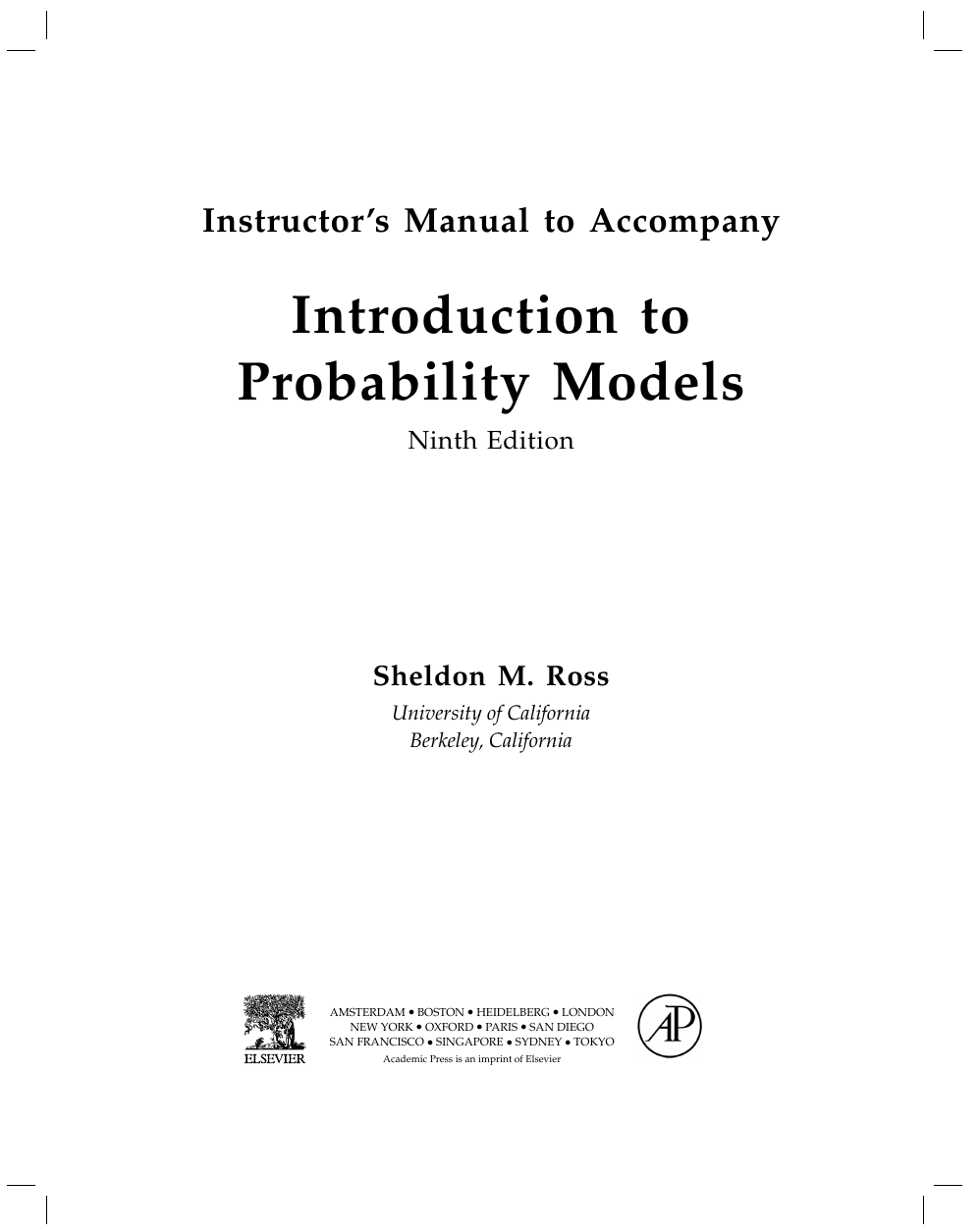
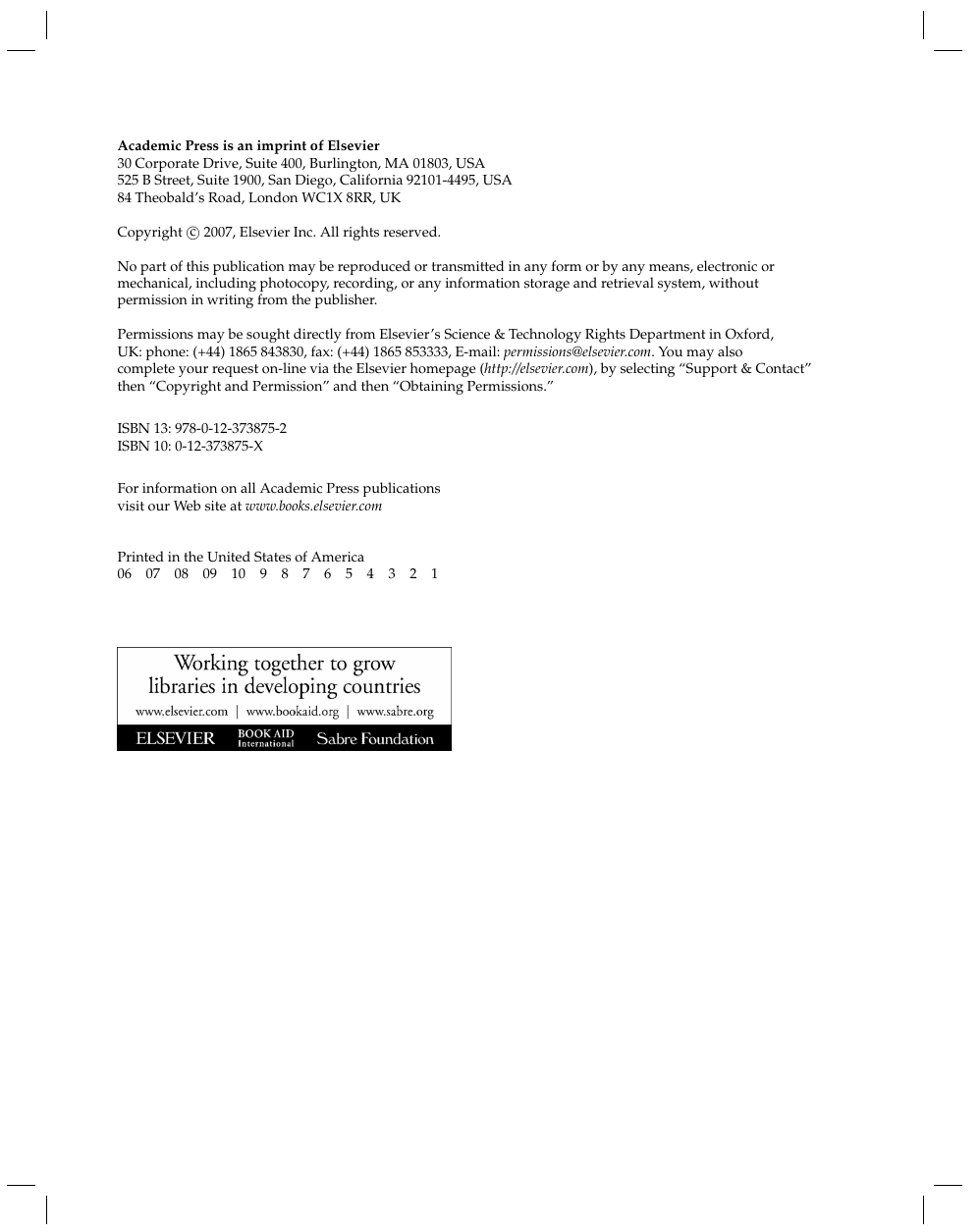
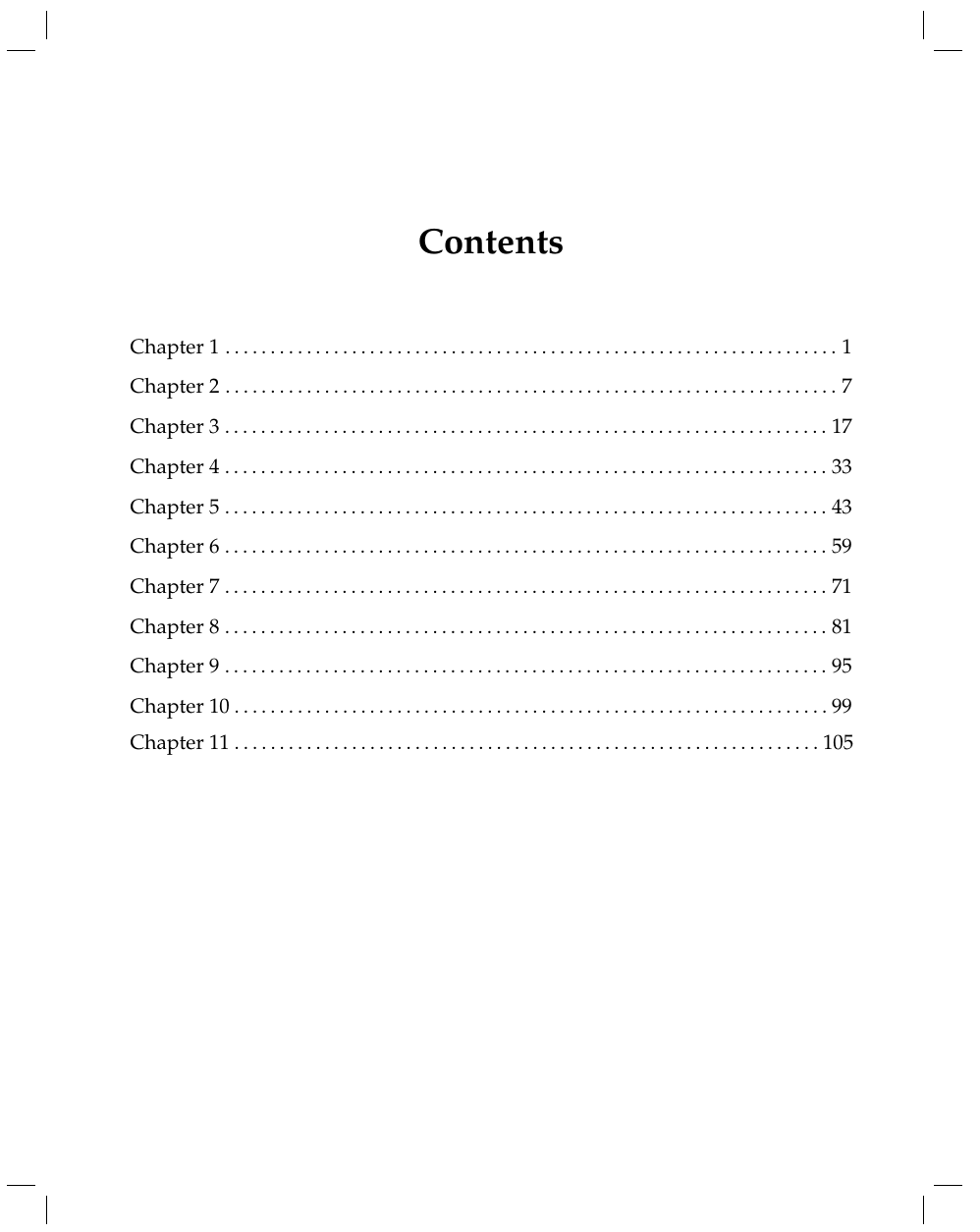

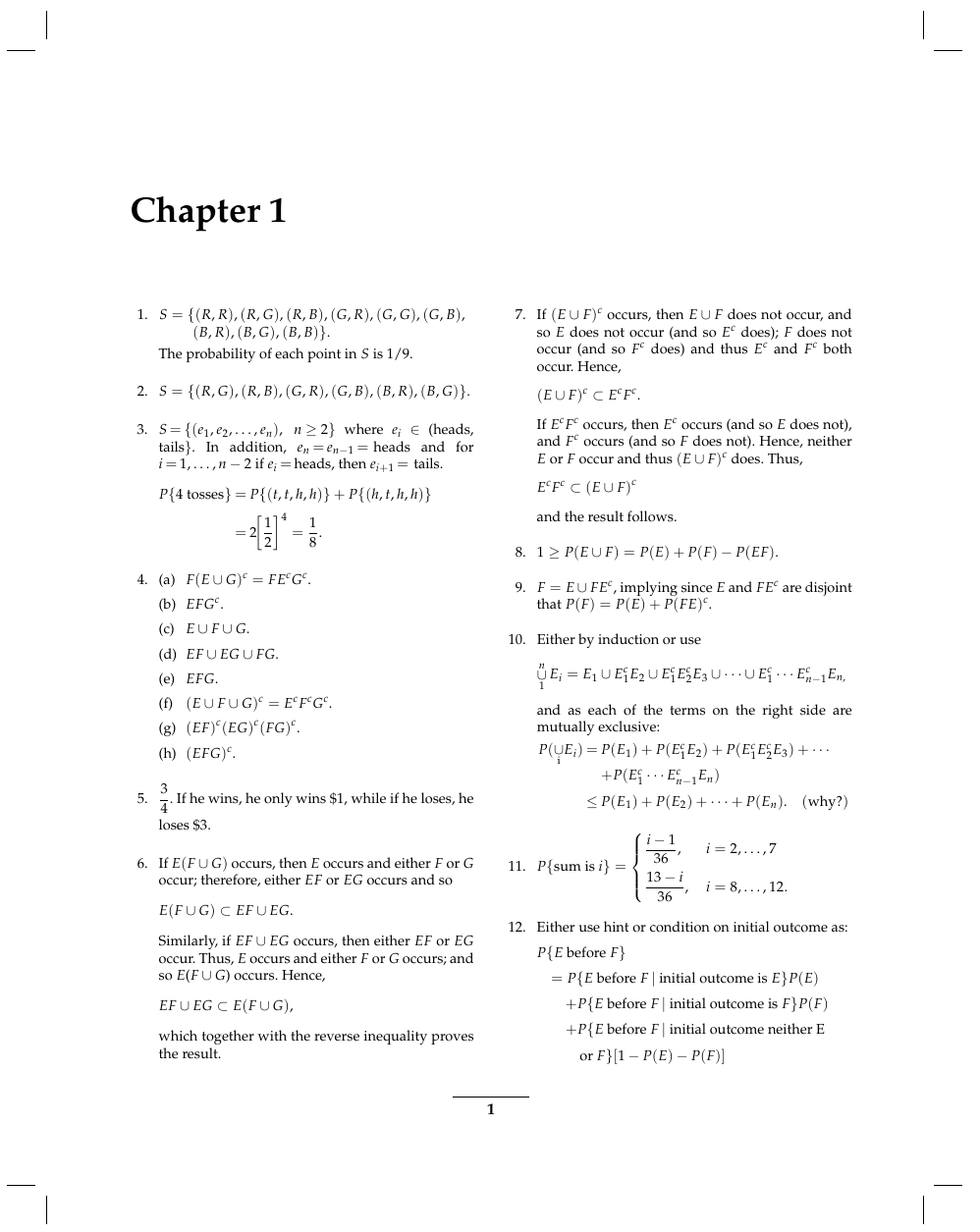
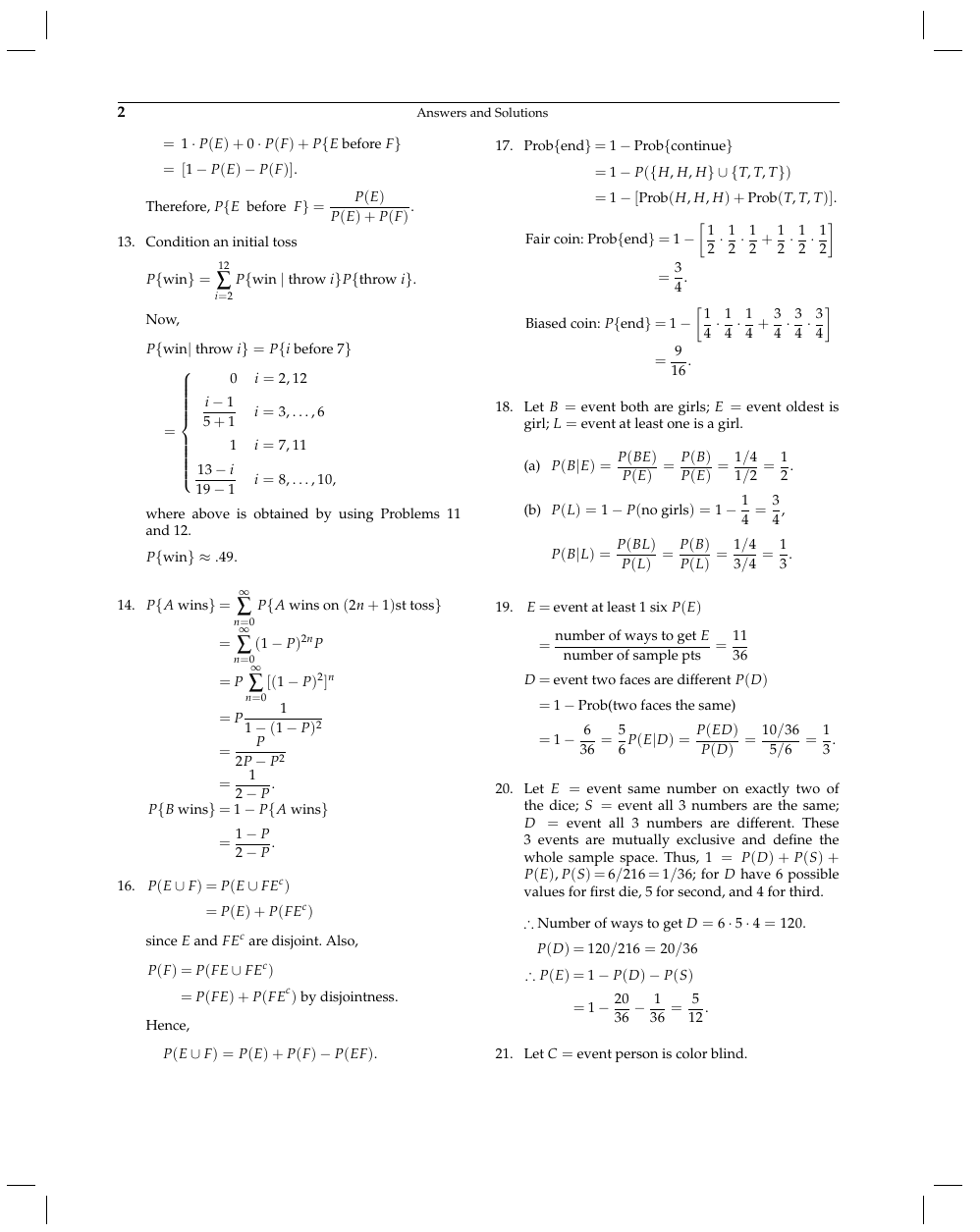
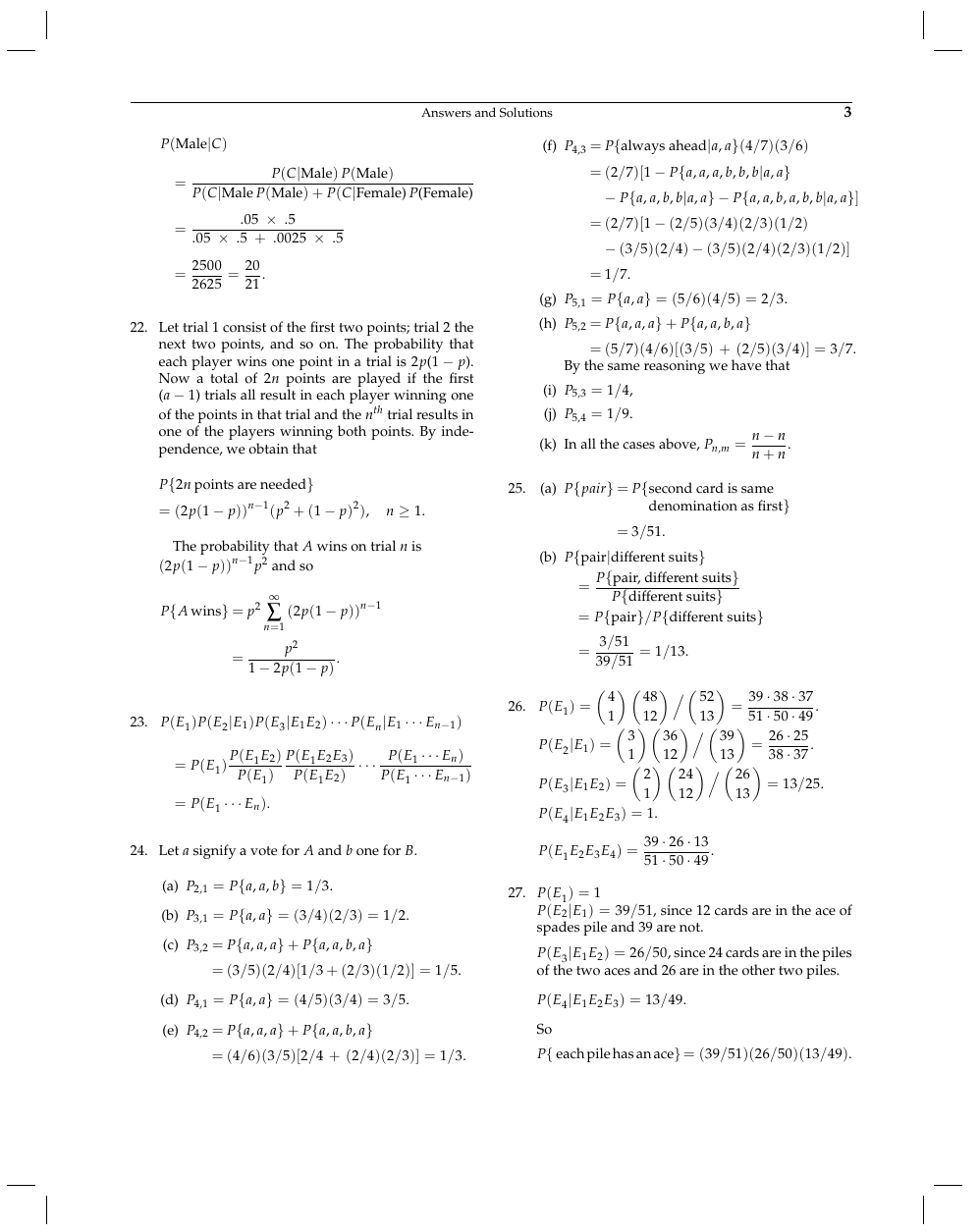
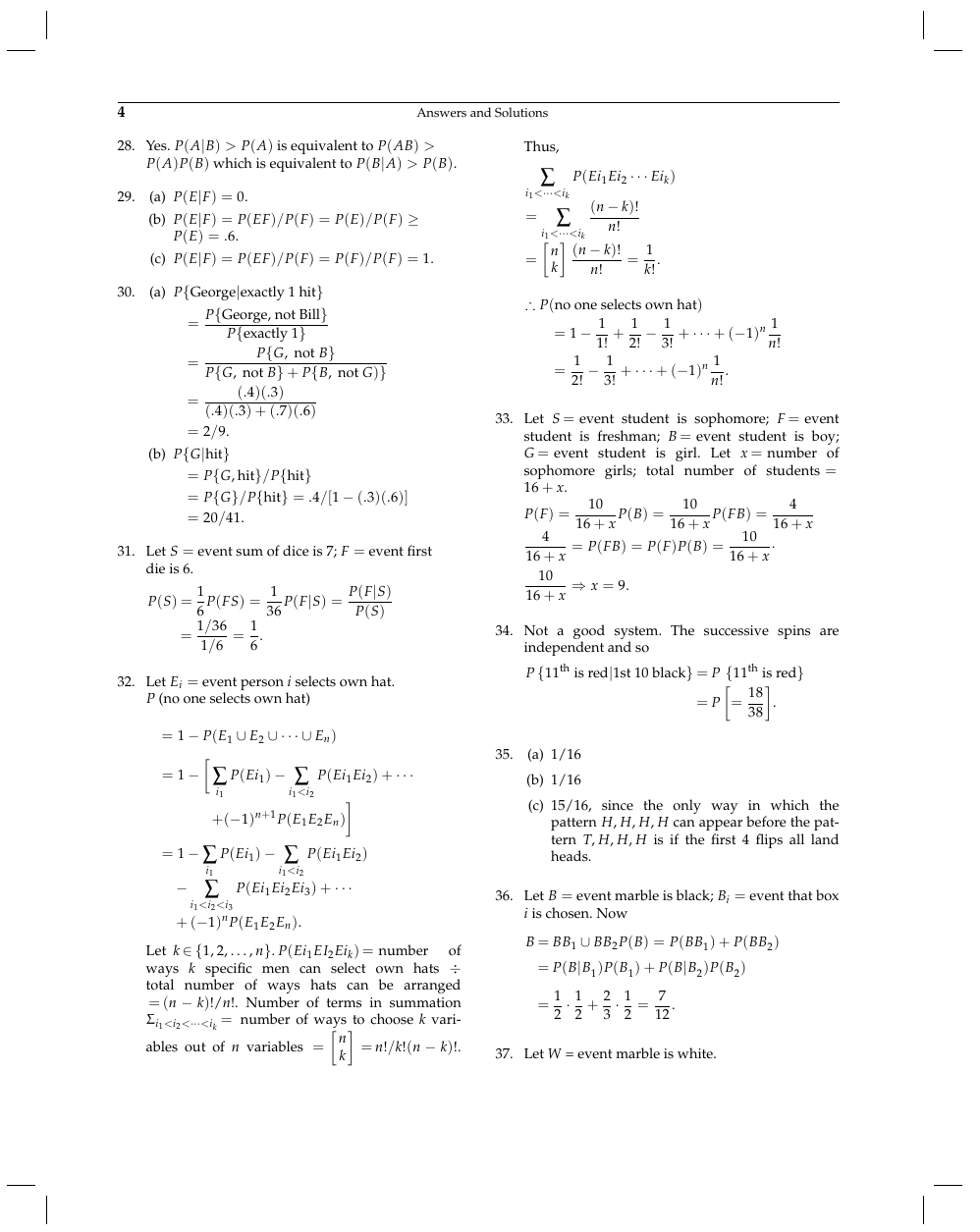








 2023年江西萍乡中考道德与法治真题及答案.doc
2023年江西萍乡中考道德与法治真题及答案.doc 2012年重庆南川中考生物真题及答案.doc
2012年重庆南川中考生物真题及答案.doc 2013年江西师范大学地理学综合及文艺理论基础考研真题.doc
2013年江西师范大学地理学综合及文艺理论基础考研真题.doc 2020年四川甘孜小升初语文真题及答案I卷.doc
2020年四川甘孜小升初语文真题及答案I卷.doc 2020年注册岩土工程师专业基础考试真题及答案.doc
2020年注册岩土工程师专业基础考试真题及答案.doc 2023-2024学年福建省厦门市九年级上学期数学月考试题及答案.doc
2023-2024学年福建省厦门市九年级上学期数学月考试题及答案.doc 2021-2022学年辽宁省沈阳市大东区九年级上学期语文期末试题及答案.doc
2021-2022学年辽宁省沈阳市大东区九年级上学期语文期末试题及答案.doc 2022-2023学年北京东城区初三第一学期物理期末试卷及答案.doc
2022-2023学年北京东城区初三第一学期物理期末试卷及答案.doc 2018上半年江西教师资格初中地理学科知识与教学能力真题及答案.doc
2018上半年江西教师资格初中地理学科知识与教学能力真题及答案.doc 2012年河北国家公务员申论考试真题及答案-省级.doc
2012年河北国家公务员申论考试真题及答案-省级.doc 2020-2021学年江苏省扬州市江都区邵樊片九年级上学期数学第一次质量检测试题及答案.doc
2020-2021学年江苏省扬州市江都区邵樊片九年级上学期数学第一次质量检测试题及答案.doc 2022下半年黑龙江教师资格证中学综合素质真题及答案.doc
2022下半年黑龙江教师资格证中学综合素质真题及答案.doc